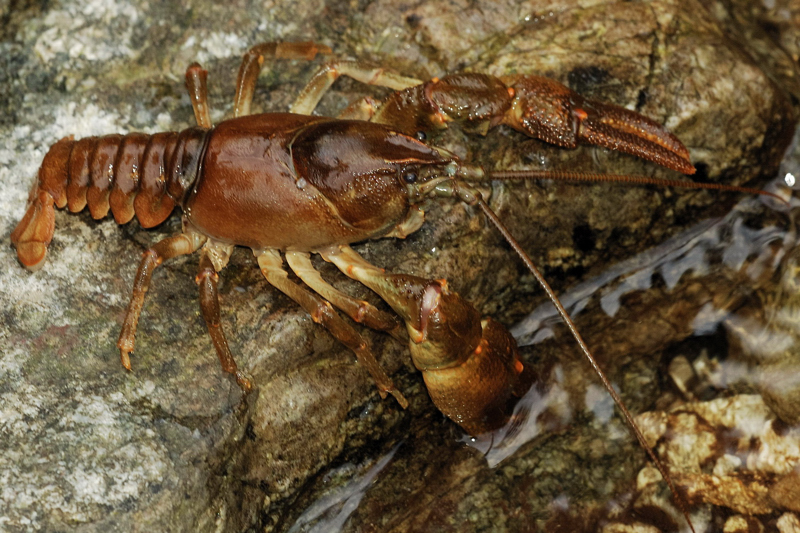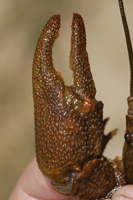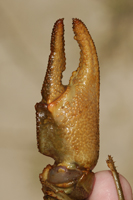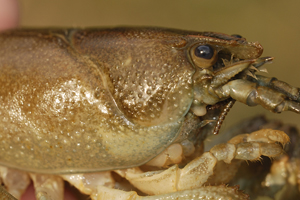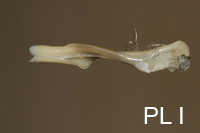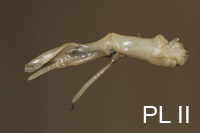|
||||
|
Austropotamobius torrentium (von Paula Schrank 1803) |
|
|||
|
General description. Distribution |
||||
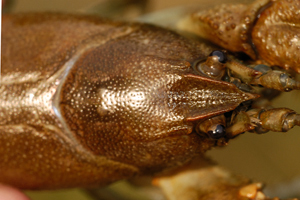
Crayfish that rarely measures over 10 cm long. The
carapace is smooth and the dorsal colour varies from dark brown to
light orange or even white, depending on several factors (like the
last moulting, the age or the habitat). The ventral is lighter in
colour almost white cream coloured, more intense on the ventral part
of the claws. The rostrum has the shape of an isosceles triangle,
smooth and having thin margins. The apex is short compared to that
of the noble crayfish. It has only one postorbital ridge without
spines. The cervical groove is smooth. The claws are quite strong,
almost like those of the noble crayfish but having shorter fingers.
The propodit has a median cavity that
has on both sides tubercles and the
dactilopodit has a single tubercle in the proximal |
||||
|
Sexual dimorphism |
||||
 
The males have often longer and stronger claws than the
females and the abdomen is larger at the females. In order to
precisely distinguish the males from the females, especially when
are young, one may verify the sternal plate and the pleopodes to be
sure. Male crayfish have the first two pairs of pleopodes strong and
oriented towards the front (for the transfer of the spermatophores)
while the female
has all the pleopodes equal. The shape of |
||||
|
Habitat and Ecology |
||||
| Its favorite habitat is the pristine running waters (springs, brooks) but it can also be found in rivers or even lakes in the mountain area. Unlike its common name it is not a species that lives in the underground waters but it can be found in this habitats with occasional floods. Usually it prefers galleries that it digs in the ground banks but it lives very often hidden under submerse roots, stones or rocks. It is more active during the night eating almost everything, that’s why it represents a truly sanitary of the waters. The juveniles eat mostly animal food like aquatic macroinvertebrates while the adults eat vegetal food or even foliated leaves that fall into water. It is sensitive to low concentration of oxygen and chemical pollution. In villages where traditional washing is practiced in the trough for washing, the population number of crayfish can suffer massive loss due to the use of detergents. The torrents regularization or the antropisation of the sub mountain regions represent a real problem for this species. The natural enemies are the fox, the wolf, the bear and the badger - for the adults, the fishes being a real threat for the juveniles. The increase in number of the North American species that are introduced in Europe represents a real threat, Pacifastacus leniusculus being capable to kill an entire population in 4 or 5 years. The parasitical diseases of viral nature, bacterial or the fungus represent very often a major problem for this species. The oomycet introduced once with the North-American species Aphanomyces astaci represents a major cause of its elimination because of the non aboriginal species. The aboriginal species do not have antibodies for this one. Ectoparasitism, without producing any damage, is frequently found at the branhiobdelides. | ||||
|
Life history |
||||
| This crayfish mate during autumn, at the end of October. During this period, white spermatophores can be observed on the sternal plate of the female. The laying contains a number of 40 to 70 eggs and it is carried by the female between the the pleopodes until the juveniles become independent. For appropriate embryonic development, the water should be around 5░C. The success rate ranges from 10 to 70% from the total laid eggs. The molting is more frequent in young crayfish and juveniles (up to 4 or 5 molting per year), while at the adults molt twice a year, usually between Mai and September. The next couple of days after this period of molting (losing its exoskeleton) are very critical for the crayfish because it loses the protection and can be easily attacked by fishes or even by other crayfish. By molting, the lost appendages can regenerate but usually appears smaller. The sexual maturity happens in 3 or 5 years, at 35 - 50 mm in total length. The males can fertilize eggs each year while the females remain sexual inactive one or more years after one laying. | ||||
|
Selective bibliography |
||||
|
1. Băcescu MC (1967) Fauna
Republicii Socialiste RomÔnia - Crustacea, Decapoda. Editura
Academiei Republicii Socialiste RomÔnia, Bucureşti 4; 4. PÔrvulescu L (2010) Crayfish field guide of Romania. Editura Bioflux, Cluj-Napoca. 5. PÔrvulescu L, PÚrez-Moreno JL, Panaiotu C, Drăguț L, Schrimpf A, Popovici ID, Zaharia C, Weiperth A, Gßl B, Schubart CD, Bracken-Grissom H (2019) A journey on plate tectonics sheds light on European crayfish phylogeography. Ecology and Evolution |
||||
